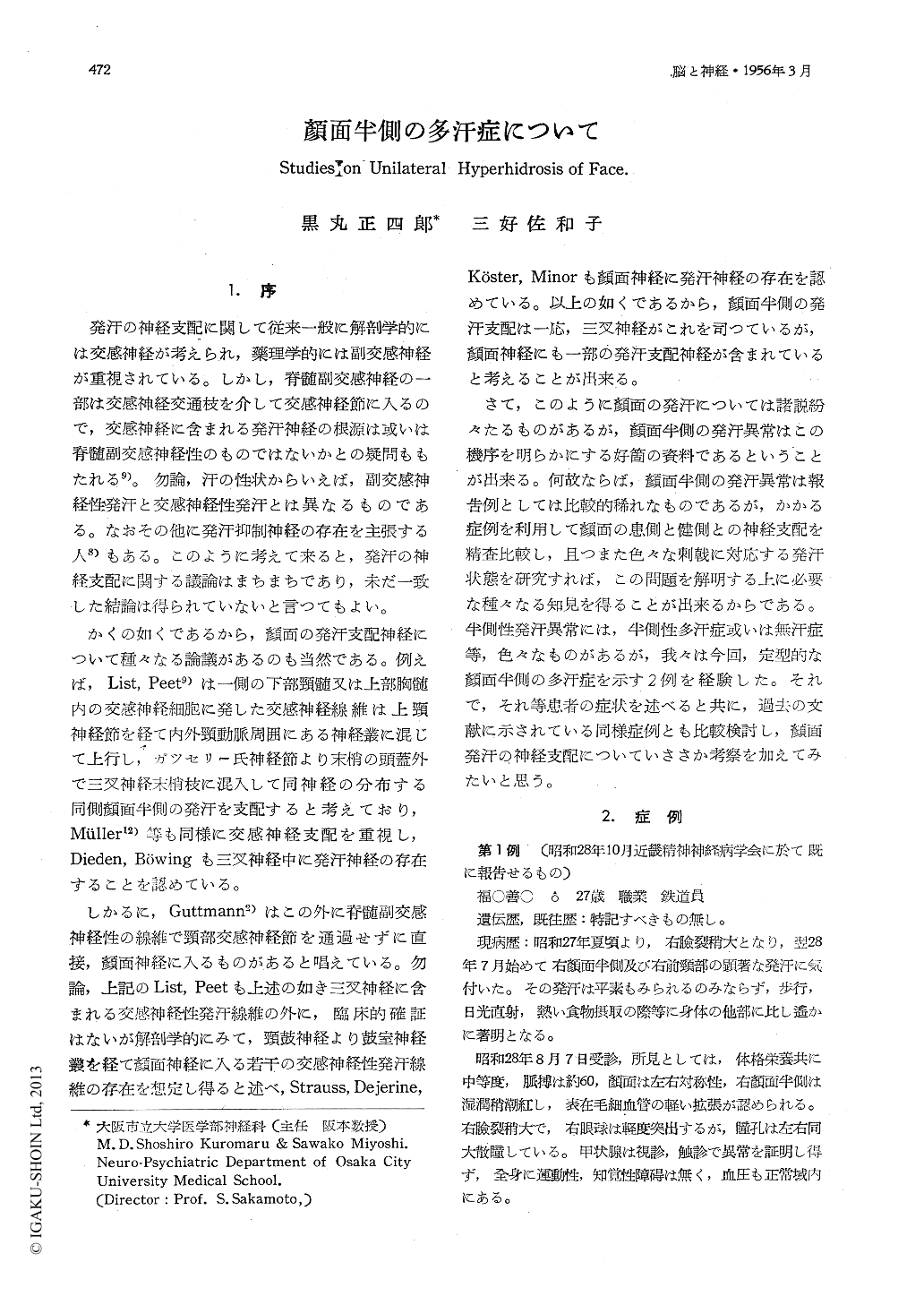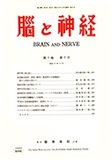Japanese
English
- 有料閲覧
- Abstract 文献概要
- 1ページ目 Look Inside
1.序
発汗の神経支配に関して従来一般に解剖学的には交感神経が考えられ,藥理学的には副交感神経が重視されている。しかし,脊髄副交感神経の一部は交感神経交通枝を介して交感神経節に入るので,交感神経に含まれる発汗神経の根源は或いは脊髄副交感神経性のものではないかとの疑問ももたれる9)。勿論,汗の性状からいえば,副交感神経性発汗と交感神経性発汗とは異なるものである。なおその他に発汗抑制神経の存在を主張する人8)もある。このように考えて来ると,発汗の神経支配に関する議論はまちまちであり,未だ一致した結論は得られていないと言つてもよい。
かくの如くであるから,顔面の発汗支配神経について種々なる論議があるのも当然である。例えば,List,Peet9)は一側の下部頸髄又は上部胸髄内の交感神経細胞に発した交感神経線維は上頸神経節を経て内外頸動脈周囲にある神経叢に混じて上行し,ガツセリー氏神経節より末梢の頭蓋外で三叉神経末梢枝に混入して同神経の分布する同側顔面半側の発汗を支配すると考えており,Müller12)等も同様に交感神経支配を重視し,Dieden, Böwingも三叉神経中に発汗神経の存在することを認めている。
しかるに,Guttmann2)はこの外に脊髄副交感神経性の線維で頸部交感神経節を通過せずに直接,顔面神経に入るものがあると唱えている。勿論,上記のList, Peetも上述の如き三叉神経に含まれる交感神経性発汗線維の外に,臨床的確証はないが解剖学的にみて,頸鼓神経より鼓室神経叢を経て顔面神経に入る若干の交感神経性発汗線維の存在を想定し得ると述べ,Strauss,Dejerine,Köster,Minorも顔面神経に発汗神経の存在を認めている。以上の如くであるから,顔面半側の発汗支配は一応,三叉神経がこれを司つているが,顔面神経にも一部め発汗支配神経が含まれていると考えることが出来る。
さて,このように顔面の発汗については諸説紛々たるものがあるが,顔面半側の発汗異常はこの機序を明らかにする好箇の資料であるということが出来る。何故ならば,顔面半側の発汗異常は報告例としては比較的稀れなものであるが,かかる症例を利用して顏面の患側と健側との神経支配を精査比較し,且つまた色友な刺戟に対応する発汗状態を研究すれば,この問題を解明する上に必要な種々なる知見を得ることが出来るからである。半側性発汗異常には,半側性多汗症或いは無汗症等,色々なものがあるが,我々は今回,定型的な顏面半側の多汗症を示す2例を経験した。それで,それ等患者の症状を述べると共に,過去の文献に示されている同様症例とも比較検討し,顏面発汗の神経支配についていささか考察を加えてみたいと思う。
Two cases of unilateral hyperhidrosis of face have been reported. Case 1, a 27 years old male. He was first seen at Osaka City Univ-ersity Medical School Hospital on Aug. 7, 1953. In summer of 1952 he began to have pa-roxisrnal sweating on the right side of face. As a rule, exposing his face to sunlight, wal-king, and taking meals gave rise to sweating. On the right side of face the skin was redd-ened and the palpebral fissure was wide even in the absence of paroxism.
Case 2, a 48 years old married female. She was first seen on sept. 24, 1954. In 1949 she began to have occasional right-sided migrain-ous attacks. In addition, an emotional strain gave rise to paroximal sweating on the right side of face.
The hyperhidrosis of both cases was not of so-called gustatory type. The hyperhidrosis appeared not only in the auriculo-temporal re-gion, but in a whole region innervated by the right trigeminal nerve. When 0.7 c.c. of 1% solution of pilocarpin was administrated subcut-aneously, sweat appeared on the left side (the healthy side) earlier than the right side (the pathological side) in both cases.
The above-mentioned cases support us con-clude that the hyperhidrosis might be due to a continuously excited state of cervial sympa-thetic nerves. Sixteen cases similar to ours have been encountered among the articles wh-ich have been availabe to us. Reviewing these 16 cases, an excited state of cervial sympath-etic nerves, the author believes, seems to be an etiological factor for hyperhidrosis in these cases, too.

Copyright © 1956, Igaku-Shoin Ltd. All rights reserved.


